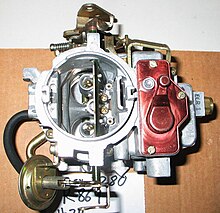While basic carburetors have only one venturi, many carburetors have more than one venturi, or "barrel". Two barrel and four barrel configurations are commonly used to accommodate the higher air flow rate with large engine displacement. Multi-barrel carburetors can have non-identical primary and secondary barrel(s) of different sizes and calibrated to deliver different air/fuel mixtures; they can be actuated by the linkage or by engine vacuum in "progressive" fashion, so that the secondary barrels do not begin to open until the primaries are almost completely open. This is a desirable characteristic which maximizes airflow through the primary barrel(s) at most engine speeds, thereby maximizing the pressure "signal" from the venturis, but reduces the restriction in airflow at high speeds by adding cross-sectional area for greater airflow. These advantages may not be important in high-performance applications where part throttle operation is irrelevant, and the primaries and secondaries may all open at once, for simplicity and reliability; also, V-configuration engines, with two cylinder banks fed by a single carburetor, may be configured with two identical barrels, each supplying one cylinder bank. In the widely seen V8 and 4-barrel carburetor combination, there are often two primary and two secondary barrels.
The spread-bore 4-barrel carburetor, first released by Rochester in the 1965 model year as the "Quadrajet" has a much greater spreadbetween the sizes of the primary and secondary throttle bores. The primaries in such a carburetor are quite small relative to conventional 4-barrel practice, while the secondaries are quite large. The small primaries aid low-speed fuel economy and drivability, while the large secondaries permit maximum performance when it is called for. To tailor airflow through the secondary venturis, each of the secondary throats has an air valve at the top. This is configured much like a choke plate, and is lightly spring-loaded into the closed position. The air valve opens progressively in response to engine speed and throttle opening, gradually allowing more air to flow through the secondary side of the carburetor. Typically, the air valve is linked to metering rods which are raised as the air valve opens, thereby adjusting secondary fuel flow.
Multiple carburetors can be mounted on a single engine, often with progressive linkages; two four-barrel carburetors (often referred to as "dual-quads") were frequently seen on high performance American V8s, and multiple two barrel carburetors are often now seen on very high performance engines. Large numbers of small carburetors have also been used (see photo), though this configuration can limit the maximum air flow through the engine due to the lack of a common plenum; with individual intake tracts, not all cylinders are drawing air at once as the engine's crankshaft rotates.


No comments:
Post a Comment